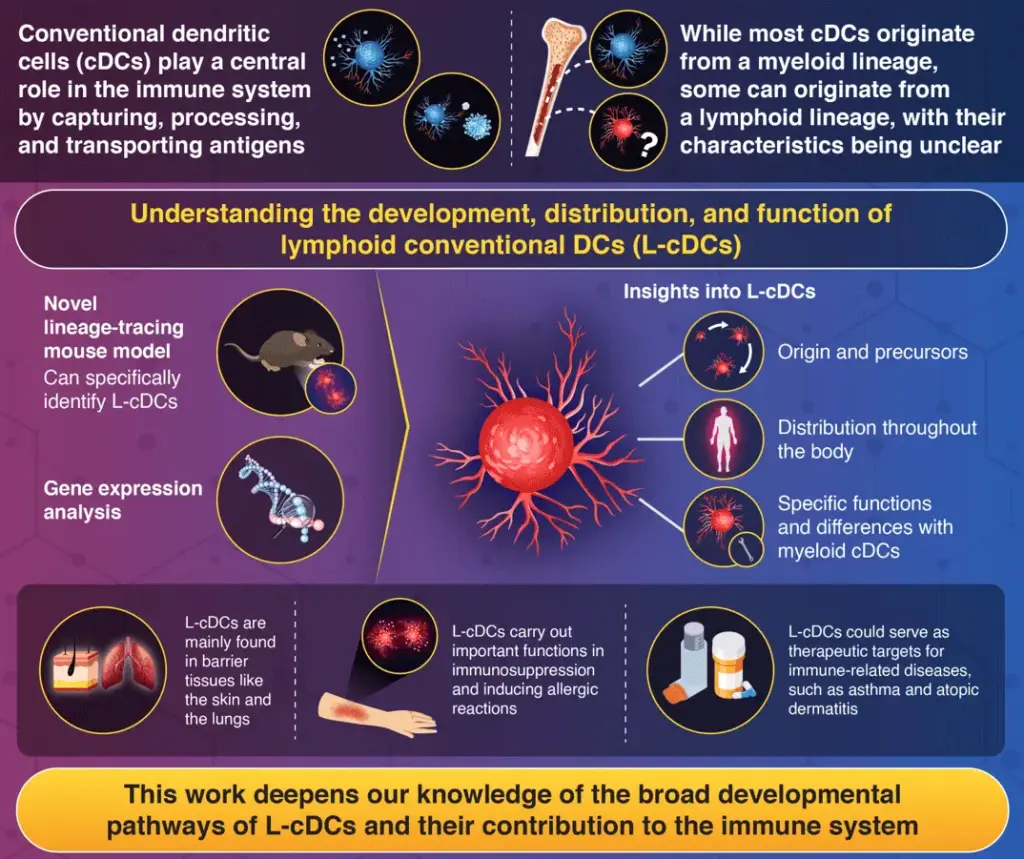
Lymphoid-derived conventional dendritic cells (L-cDCs) may play a unique role in immune suppression and allergy induction, according to a recent study by researchers in Japan. Previously believed to originate solely from myeloid lineages, new findings reveal that conventional dendritic cells (cDCs) also arise from lymphoid progenitors. This discovery, using fluorescent reporter mice, highlights their abundance in barrier tissues like the skin and lungs, along with distinct genetic signatures and functions.
Unveiling the Role of Lymphoid-Derived Dendritic Cells
Conventional dendritic cells (cDCs) are pivotal in the immune system, acting as primary orchestrators of adaptive immunity. These specialized cells capture and process antigens, presenting them to T cells to initiate robust immune responses critical for combating infections and cancers. Traditionally, it was understood that cDCs originate exclusively from myeloid lineage cells, a well-established developmental pathway in immunology.
However, emerging evidence suggests that cDCs can also develop from lymphoid lineages, which include T cells, B cells, and natural killer cells. The developmental pathways, tissue distribution, and functional roles of these lymphoid-derived cDCs (L-cDCs) have been unclear, prompting ongoing scientific debate.
Research Breakthrough from Japan
To bridge this knowledge gap, a research team led by Professor Toshiaki Ohteki from the Institute of Integrated Research at Science Tokyo, Japan, delved into the underexplored world of L-cDCs. Their paper, published in Science Advances on June 6, 2025, reveals intriguing characteristics of this immune cell population.
The researchers employed genetically engineered ‘reporter mice’ with fluorescent tags to track lymphoid lineage cells throughout the body. This innovative approach uncovered that while L-cDCs are a minor population in general lymphoid tissues, they are abundant in barrier tissues such as the lungs and skin. Comprehensive gene expression analyses confirmed their lymphoid lineage, revealing specific lymphocyte signature genes.
“These lymphoid-derived cDCs exhibited potent functions in immune suppression and allergy induction and appear to follow diverse developmental pathways,”
remarks Ohteki.
Functional Distinctions and Implications
Functionally, L-cDCs display distinct characteristics compared to their myeloid-derived counterparts. Under low antigen stimulation, L-cDC2s (a specific subtype) show a reduced capacity to activate T cells. However, with sufficient antigen stimulation, L-cDC2s preferentially promote T helper 2 (TH2) differentiation. This dual functionality—high threshold for T cell activation combined with strong TH2-promoting capacity—suggests their role in maintaining tissue homeostasis and driving allergic responses.
The findings open avenues for understanding the immune system more comprehensively. They suggest that L-cDCs could serve as promising therapeutic targets for TH2-related diseases such as asthma and atopic dermatitis, where uncontrolled TH2 responses contribute to pathology.
Convergent Evolution in Immunology
The existence of cDCs originating from both myeloid and lymphoid progenitors, yet performing similar core functions, points to a fascinating biological phenomenon.
“In evolutionary biology, the evolution of independent organisms with similar traits from different lineages in a particular environment is known as convergent evolution, as seen in the morphology of dolphins and sharks,”
explains first author Kanayama.
“The development of cDCs from myeloid and lymphoid progenitors implies the existence of convergent evolution at the cellular level. Directing future research, whether such convergent evolution is a phenomenon limited to the immune system or is also observed in other systems, will provide us with remarkable answers.”
Future Directions and Research Opportunities
This groundbreaking study not only challenges existing paradigms in immunology but also sets the stage for further research. Understanding the additional roles these cells play in immunity and cellular biology could lead to novel therapeutic strategies. The implications of convergent evolution at the cellular level could extend beyond immunology, potentially offering insights into other biological systems.
As researchers continue to explore the complexities of the immune system, the hope is that these findings will lead to better treatments for immune-related diseases. Further studies will be crucial in uncovering the full spectrum of functions and impacts of lymphoid-derived dendritic cells.







